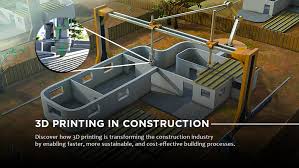
Construction is entering a high-tech revolution. With 3D printing, buildings and infrastructure can be created faster, cheaper, and more sustainably than traditional methods. From small homes to complex bridges, additive manufacturing is transforming the construction industry.
1. What Is 3D Printing in Construction?
3D printing, also called additive manufacturing, builds structures layer by layer using materials such as concrete, polymers, or metal alloys. Key features include:
- Precision: Complex designs are built exactly as planned.
- Automation: Robots and printers reduce reliance on manual labor.
- Material efficiency: Minimal waste compared to traditional construction.
- Customization: Allows architects and engineers to create unique structures with ease.
This technology can reshape how cities are built while addressing labor shortages and environmental concerns.
2. Benefits of 3D-Printed Construction
- Speed: Entire homes or components can be printed in days instead of months.
- Cost reduction: Less labor and material waste lowers overall project costs.
- Sustainability: Uses recycled or locally sourced materials, reducing environmental impact.
- Design freedom: Complex architectural elements that are difficult with conventional methods become feasible.
- Disaster relief: Quickly provides shelters in areas affected by natural disasters.
3. Real-World Applications
- Housing: Startups and governments are using 3D printing to build affordable homes rapidly.
- Bridges: 3D-printed concrete bridges in Europe and Asia showcase durability and design flexibility.
- Commercial buildings: Offices and retail spaces are being constructed using large-scale 3D printers.
- Space exploration: NASA and other agencies are exploring 3D printing habitats using lunar or Martian soil.
These examples show the versatility and scalability of 3D printing in construction.
4. Challenges to Overcome
- Material limitations: Concrete and other materials must meet strict strength and durability standards.
- Regulation and codes: Building codes must adapt to include 3D-printed structures.
- Initial investment: Large-scale 3D printers are expensive, making entry barriers high.
- Skill gap: Engineers and construction workers need training in digital design and printer operation.
5. The Future of Construction
As technology evolves, 3D printing could enable:
- Fully automated construction sites.
- Personalized homes tailored to individual preferences.
- Rapid response housing for humanitarian crises.
- Reduced carbon footprint in urban development projects.
3D printing is not just a tool—it represents a shift in the entire construction paradigm, combining speed, sustainability, and creativity.
Final Thoughts
3D printing in construction offers a glimpse of the future, where buildings are created efficiently, affordably, and sustainably. By embracing this technology, cities and industries can tackle housing shortages, labor challenges, and environmental concerns while unlocking new architectural possibilities.